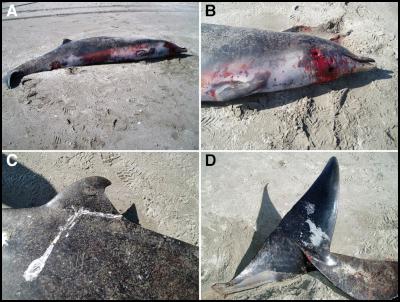First sighting of world’s rarest whale
Media release
Faculty of Science
The University of
Auckland
6 November 2012
First sighting of
world’s rarest whale
The world’s rarest whale,
the spade-toothed beaked whale, has been sighted for the
first time according to scientists from The University of
Auckland.
“This is the first time a spade-toothed beaked whale has been seen as a complete specimen, and we were lucky enough to find two of them,” says lead scientist Dr Rochelle Constantine.
“It’s incredible to think that, until recently, such a large animal was concealed in the South Pacific Ocean and shows how little we know about ocean biodiversity.”
In a study published today in Current Biology, the scientists used DNA evidence to prove that a mother and her male calf which stranded in New Zealand in late 2010 were the first animals of their kind ever seen.
Since the two animals are the only intact members of their species sighted, the spade-toothed beaked whale is the world’s rarest whale.
Until now the only evidence for the species’ existence came from three skull and jaw fragments found around New Zealand and Robinson Crusoe Island, Chile.
The spade-toothed beaked whale was discovered on Pitt Island in the Chatham Islands in 1872, but it wasn’t until 2002 that scientists from The University of Auckland analysed DNA from the three skull fragments, recovered from museum archives, and realised that their genetic profiles were the same and did not correspond to any other known species.

Figure from the supplemental information to the paper in Current Biology - The world’s rarest whale. Photo credit: Department of Conservation
There was sufficient DNA evidence to confirm that these three scattered specimens were the bones of the spade-toothed beaked whale. Until the stranding, however, it was unclear whether the species still existed.
On December 31, 2010, a female whale (5.3m long) and male calf (3.5m) stranded and later died on Opape Beach in the Bay of Plenty, New Zealand. After death they were measured, photographed and tissue samples were taken by the Department of Conservation.
The animals were initially misidentified as Gray’s beaked whales, the most common beaked whale to strand in New Zealand. However subsequent genetic analysis at The University of Auckland revealed that they were spade-toothed beaked whales.
Following genetic identification the skeletal remains were exhumed, with the permission of Whakatohea Iwi Maori Trust and the Ngai Tama Haua hapu, and taken to the Museum of New Zealand Te Papa Tongarewa.
“This is a real New Zealand story – it’s all linked here, from the discovery of two of the bone fragments to the identification of the species and now the first sighting of the whales,” says Dr Constantine.
“In New Zealand we have a very well established network whereby members of the public report stranded marine mammals to the Department of Conservation, which collects information and sends tissue samples to our laboratory at The University of Auckland.”
“This discovery is a real reward for that work. It demonstrates the value of archival collections and the power of DNA as a forensic tool.”
ends


 Business Canterbury: Urges Council To Cut Costs, Not Ambition For City
Business Canterbury: Urges Council To Cut Costs, Not Ambition For City Wellington Airport: On Track For Net Zero Emissions By 2028
Wellington Airport: On Track For Net Zero Emissions By 2028 Landcare Research: ANZAC Gall Fly Release Promises Natural Solution To Weed Threat
Landcare Research: ANZAC Gall Fly Release Promises Natural Solution To Weed Threat NZ Anti-Vivisection Society: Auckland Rat Lovers Unite!
NZ Anti-Vivisection Society: Auckland Rat Lovers Unite! University of Canterbury: $1.35 Million Grant To Study Lion-like Jumping Spiders
University of Canterbury: $1.35 Million Grant To Study Lion-like Jumping Spiders Federated Farmers: Government Ends War On Farming
Federated Farmers: Government Ends War On Farming



